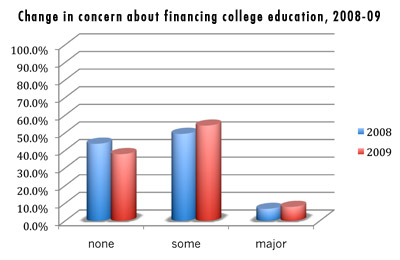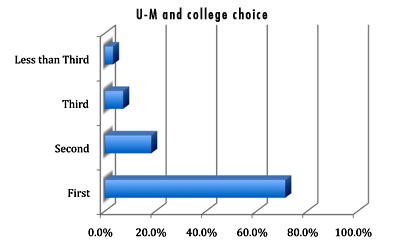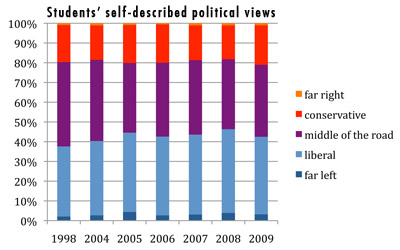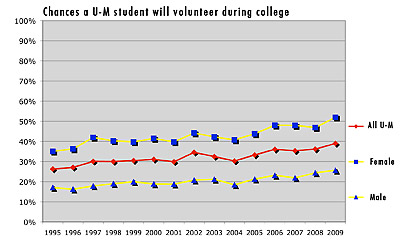Each year since 1993, U-M at Ann Arbor participates in the Cooperative Institutional Research Program (CIRP) national survey of students who are beginning their undergraduate studies. CIRP provides a baseline profile of entering full-time undergraduate students and opens a unique window to trends that affect how the university creates meaningful learning experiences for them.
The CIRP longitudinal study of the American higher education system started in 1966 with the American Council on Education, and today is conducted jointly by ACE and the University of California at Los Angeles. Student Affairs Research within the Division of Student Affairs administers the CIRP survey at U-M.
Items within the survey include students’ self-reported reasons for attending college and for choosing U-M, as well as their hopes and expectations for the educational experience. The responses also provide information on family background and high school activities, and give insight into attitudes and viewpoints on selected social issues.
During the past 17 years, 74,884 entering U-M students have participated in CIRP. In 2009, 4,750 students responded to the survey yielding a 78.1 percent response rate.
The economy

This year’s incoming class is reporting significantly more concern about the ability to pay for college (see Change in Financial Concern graphic).
While 43.8 percent of the 2008 entering class expressed no concern with financing college, only 37.9 percent of the 2009 entering class expressed a similar lack of concern. Since 93.4 percent of U-M students report expecting some level of family resources going toward their college educations, the concern may reflect the rise in unemployment.
U-M students, like their peers nationally, are seeing parents, particularly mothers, experience higher unemployment. While across the nation 4.5 percent of first-year students had unemployed fathers and 7.9 percent had unemployed mothers, at U-M 0.9 percent of fathers, and 7.4 percent of mothers, are unemployed. Unemployment figures exclude those parents designated as homemakers; percentages for both parents remained relatively flat during this time.
College choice

U-M most frequently is listed as a “first choice” by its students (see College Choice graphic). In 2009 71.3 percent of entering students indicated that it was the top choice, and another 18.3 percent indicated that it was a second choice. There has been little variation in this choice level over the previous five and 10 years. Almost three-quarters of entering students consistently state that U-M was their top choice.
Political perspective
While U-M students entering in 2008 reported being slightly more “liberal” than U-M students in prior years, the general pattern of student political positions returned to a more customary pattern in 2009. In part, much of this can be seen as the “middle of the road” regaining ground, as it typically does in non-election years. Of U-M students, 41.5 percent reported being “liberal” (compared with 29.0 percent nationally); and 21 percent of U-M students reported being “conservative” (compared with 21.8 percent nationally). The percentage of U-M conservative students has remained relatively stable over the past decade.

“University of Michigan students demonstrate a diversity of political thought that supports rich discussion and debate among students throughout the campus community,” says Malinda Matney, senior research associate, Division of Student Affairs.
While entering students give themselves relatively consistent political-view labels overall, their positions on hot-button issues continue to shift. For example, while support has gradually grown for same-sex marriage, it has gradually eroded for federal control of the sale of handguns.
What university officials see in the data is the suggestion that traditional labels “liberal” or “conservative” are changing in construction.
“We are seeing generational differences in what the labels ‘liberal’ and ‘conservative’ mean to the ‘millennial’ student,” Matney says.
Community engagement

Students are invigorating a commitment to volunteerism. More than half of U-M entering female students (52 percent) and over a quarter of U-M entering male students (25.7 percent) plan to volunteer or engage in community service during college.
“This is exciting because of the ways they will engage with the community while at U-M learning about social issues, and also because of the ways the community can influence their educational experience,” Matney says. “These students will roll up their sleeves and grapple with real world problems, which will better equip them for life after college.”
For more information about Student Affairs research at U-M, go to www.umich.edu/~rsa/factbook.html.

